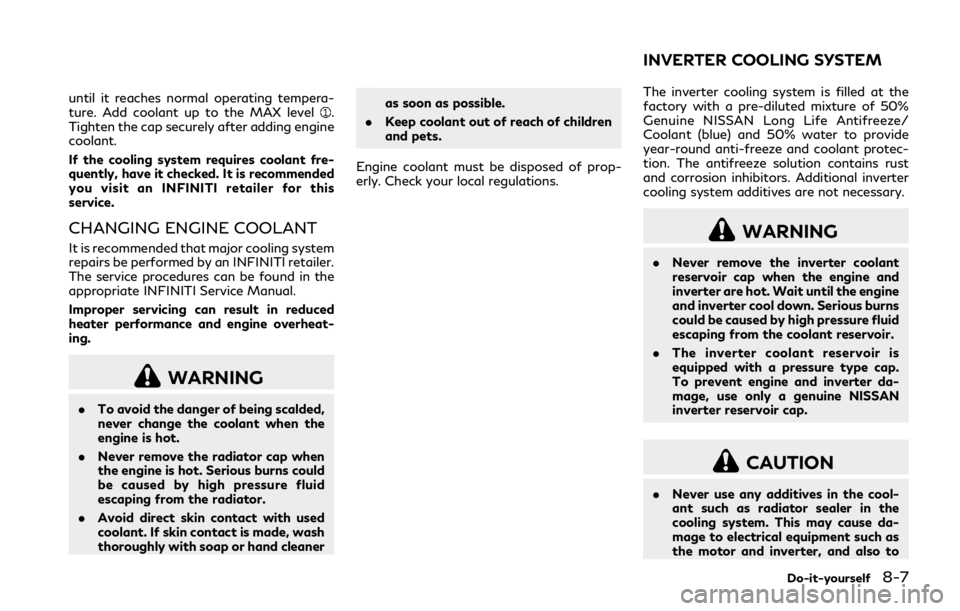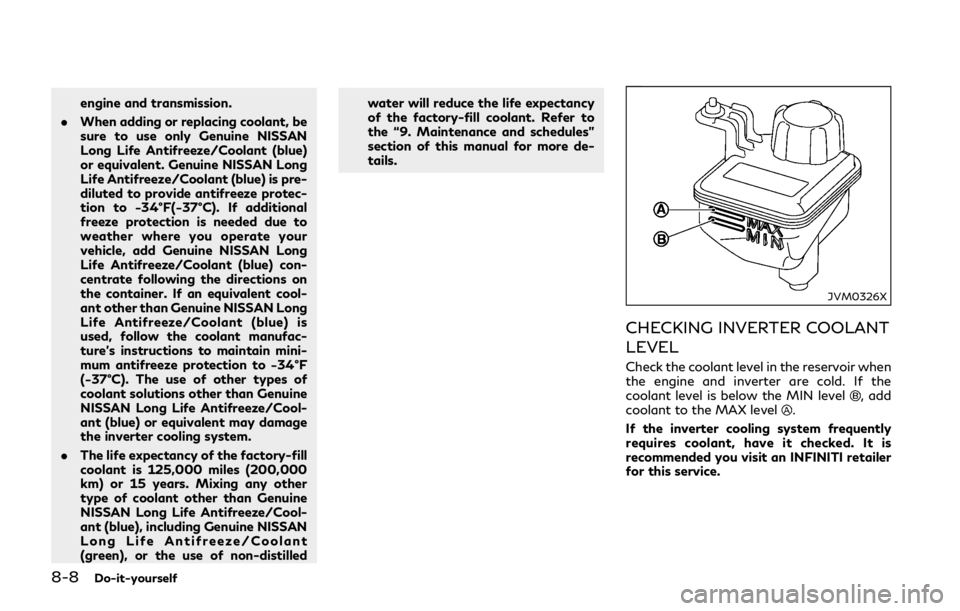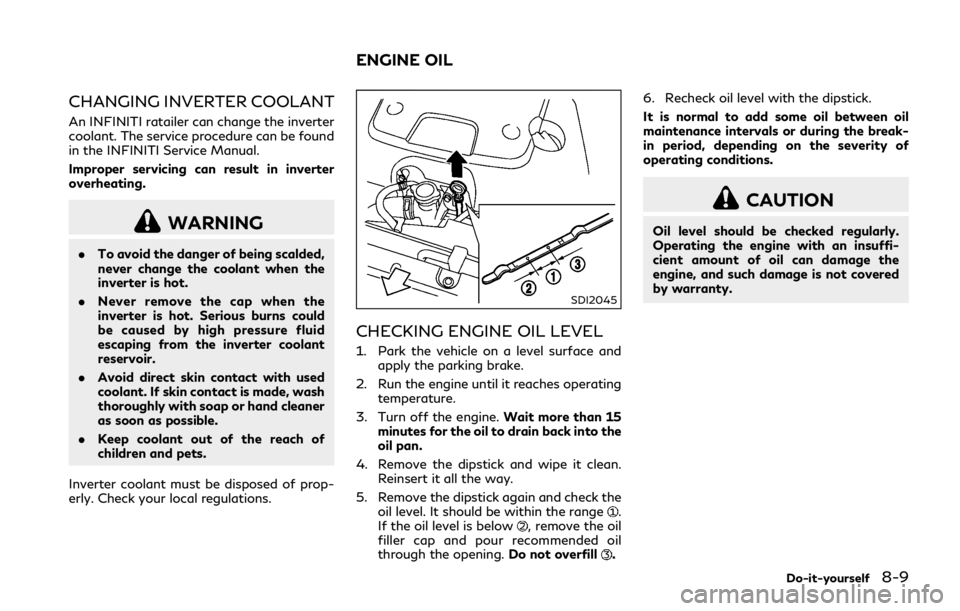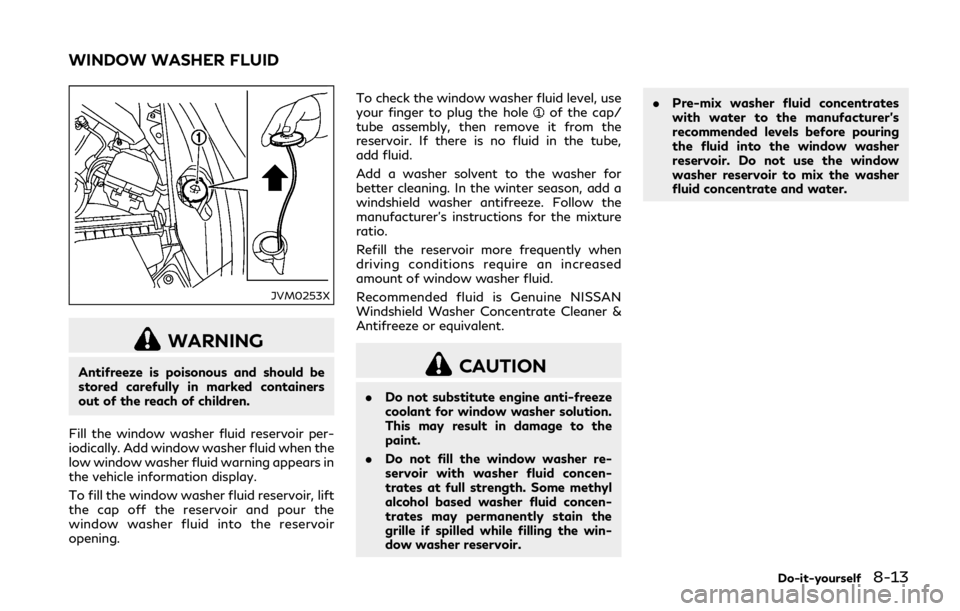engine coolant INFINITI Q50 HYBRID 2018 User Guide
[x] Cancel search | Manufacturer: INFINITI, Model Year: 2018, Model line: Q50 HYBRID, Model: INFINITI Q50 HYBRID 2018Pages: 440, PDF Size: 2.8 MB
Page 347 of 440

8 Do-it-yourself
Maintenance precautions ................................................ 8-2
Engine compartment check locations ......................... 8-3VQ35HR engine ........................................................... 8-3
Engine cooling system ..................................................... 8-5 Checking engine coolant level .................................. 8-6
Changing engine coolant ........................................... 8-7
Inverter cooling system ................................................... 8-7 Checking inverter coolant level ................................ 8-8
Changing inverter coolant ......................................... 8-9
Engine oil ........................................................................\
..... 8-9
Checking engine oil level ............................................ 8-9
Changing engine oil and oil filter .......................... 8-10
Automatic Transmission Fluid (ATF) ......................... 8-12
Brake fluid ........................................................................\
. 8-12
Window washer fluid ..................................................... 8-13
12-volt battery ................................................................. 8-14
Checking battery fluid level .................................... 8-15
Jump starting .............................................................. 8-15
Spark plugs ........................................................................\
8-15 Replacing spark plugs ............................................... 8-16
Air cleaner ........................................................................\
.. 8-16 Windshield wiper blades ............................................... 8-17
Cleaning ...................................................................... 8-17
Replacing .................................................................... 8-18
Brakes ........................................................................\
........ 8-18 Self-adjusting brakes .............................................. 8-18
Brake pad wear warning ....................................... 8-18
Fuses ........................................................................\
.......... 8-19 Engine compartment and trunk ........................... 8-19
Passenger compartment ....................................... 8-20
Intelligent Key battery replacement .......................... 8-21
Lights ........................................................................\
........ 8-24 Headlights .................................................................. 8-25
Exterior and interior lights .................................... 8-25
Wheels and tires ............................................................ 8-28 Tire pressure ............................................................. 8-28
Tire labeling ............................................................... 8-32
Types of tires ........................................................... 8-34
Tire chains .................................................................. 8-35
Changing wheels and tires .................................... 8-36
Jacking up the vehicle and replacing tires ........ 8-39
Page 349 of 440

.Avoid direct contact with used en-
gine oil and coolant. Improperly dis-
posed engine oil, coolant, and/or
other vehicle fluids can damage the
environment. Always conform to lo-
cal regulations for disposal of vehicle
fluid.
. Never leave the engine or the trans-
mission related component harness
connector disconnected while the
ignition switch is in the ON position.
. Never connect or disconnect the 12-
volt battery or any transistorized
component while the ignition switch
is in the ON position.
This “8. Do-it-yourself” section gives in-
structions regarding only those items which
are relatively easy for an owner to perform.
A genuine INFINITI Service Manual is also
available. (See “Owner’s Manual/Service
Manual order information” (P.10-22).)
You should be aware that incomplete or
improper servicing may result in operating
difficulties or excessive emissions, and could
affect your warranty coverage. If in doubt
about any servicing, it is recommended you
have it done by an INFINITI retailer.
JVM0249X
VQ35HR ENGINE
To remove the engine compartment cover,
unhook the clips located as illustrated.
Do-it-yourself8-3
ENGINE COMPARTMENT CHECK
LOCATIONS
Page 350 of 440

8-4Do-it-yourself
JVM0294X
1. Engine oil filler cap
2. Brake fluid reservoir
3. Fuse/fusible link holder
4. Air cleaner
5. Inverter coolant reservoir
6. Radiator filler cap
7. Engine coolant reservoir
8. Engine oil dipstick
9. Window washer fluid reservoirThe 12-volt battery is located inside the
trunk.
Page 351 of 440

The engine cooling system is filled at the
factory with a pre-diluted mixture of 50%
Genuine NISSAN Long Life Antifreeze/
Coolant (blue) and 50% water to provide
year-round anti-freeze and coolant protec-
tion. The anti-freeze solution contains rust
and corrosion inhibitors. Additional engine
cooling system additives are not necessary.
WARNING
.Never remove the radiator cap when
the engine is hot. Wait until the
engine and radiator cool down. Ser-
ious burns could be caused by high
pressure fluid escaping from the
radiator. See precautions in “If your
vehicle overheats” (P.6-8) of this
manual.
. The radiator is equipped with a
pressure type radiator cap. To pre-
vent engine damage, use only a
genuine NISSAN radiator cap.
CAUTION
.Never use any cooling system addi-
tives such as radiator sealer. Addi-
tives may clog the cooling system and
cause damage to the engine, trans- mission and/or cooling system.
. When adding or replacing coolant, be
sure to use only Genuine NISSAN
Long Life Antifreeze/Coolant (blue)
or equivalent. Genuine NISSAN Long
Life Antifreeze/Coolant (blue) is pre-
diluted to provide antifreeze protec-
tion to −34°F(−37°C). If additional
freeze protection is needed due to
weather where you operate your
vehicle, add Genuine NISSAN Long
Life Antifreeze/Coolant (blue) con-
centrate following the directions on
the container. If an equivalent cool-
ant other than Genuine NISSAN Long
Life Antifreeze/Coolant (blue) is
used, follow the coolant manufac-
ture’s instructions to maintain mini-
mum antifreeze protection to −34°F
(−37°C). The use of other types of
coolant solutions other than Genuine
NISSAN Long Life Antifreeze/Cool-
ant (blue) or equivalent may damage
the engine cooling system.
. The life expectancy of the factory-fill
coolant is 105,000 miles (168,000
km) or 7 years. Mixing any other type
of coolant other than Genuine
NISSAN Long Life Antifreeze/Cool-
ant (blue), including Genuine NISSAN
Long Life Antifreeze/ Coolant
(green), or the use of non-distilled water will reduce the life expectancy
of the factory-fill coolant. Refer to
the “9. Maintenance and schedules”
section of this manual for more de-
tails.
Do-it-yourself8-5
ENGINE COOLING SYSTEM
Page 352 of 440

8-6Do-it-yourself
JVM0251X
CHECKING ENGINE COOLANT
LEVEL
Models with non-pressurized ra-
diator reservoir tank
Check the coolant levelin the reservoir
when the engine is cold. If the coolant level
is below MIN
, open the reservoir tank cap
and add coolant up to the MAXlevel. If the
reservoir tank is empty, check the coolant
level in the radiator when the engine is cold.
If there is insufficient coolant in the radiator,
fill the radiator with coolant up to the filler
opening and also add it to the reservoir tank
up to the MAX level
. Tighten the cap securely after adding engine
coolant.
If the cooling system requires coolant fre-
quently, have it checked. It is recommended
you visit an INFINITI retailer for this
service.
JVM0343X
Models with pressurized radiator
reservoir tank
Check the coolant level in the reservoir tank
when the engine is running and after it
reaches normal operating temperature. If
the coolant level is below MIN level
, add
coolant up to the MAX level. If the
reservoir tank is empty, check the coolant
level in the radiator when the engine is cold.
If there is insufficient coolant in the radiator,
fill the radiator with coolant up to the filler
cap above the radiator upper hose opening
and also add it to the reservoir tank up to the
MAX level
. Put on the filler cap above the
radiator upper hose and with the reservoir
cap open, start the engine. Run the engine
Page 353 of 440

until it reaches normal operating tempera-
ture. Add coolant up to the MAX level.
Tighten the cap securely after adding engine
coolant.
If the cooling system requires coolant fre-
quently, have it checked. It is recommended
you visit an INFINITI retailer for this
service.
CHANGING ENGINE COOLANT
It is recommended that major cooling system
repairs be performed by an INFINITI retailer.
The service procedures can be found in the
appropriate INFINITI Service Manual.
Improper servicing can result in reduced
heater performance and engine overheat-
ing.
WARNING
. To avoid the danger of being scalded,
never change the coolant when the
engine is hot.
. Never remove the radiator cap when
the engine is hot. Serious burns could
be caused by high pressure fluid
escaping from the radiator.
. Avoid direct skin contact with used
coolant. If skin contact is made, wash
thoroughly with soap or hand cleaner as soon as possible.
. Keep coolant out of reach of children
and pets.
Engine coolant must be disposed of prop-
erly. Check your local regulations. The inverter cooling system is filled at the
factory with a pre-diluted mixture of 50%
Genuine NISSAN Long Life Antifreeze/
Coolant (blue) and 50% water to provide
year-round anti-freeze and coolant protec-
tion. The antifreeze solution contains rust
and corrosion inhibitors. Additional inverter
cooling system additives are not necessary.
WARNING
.
Never remove the inverter coolant
reservoir cap when the engine and
inverter are hot. Wait until the engine
and inverter cool down. Serious burns
could be caused by high pressure fluid
escaping from the coolant reservoir.
. The inverter coolant reservoir is
equipped with a pressure type cap.
To prevent engine and inverter da-
mage, use only a genuine NISSAN
inverter reservoir cap.
CAUTION
.Never use any additives in the cool-
ant such as radiator sealer in the
cooling system. This may cause da-
mage to electrical equipment such as
the motor and inverter, and also to
Do-it-yourself8-7
INVERTER COOLING SYSTEM
Page 354 of 440

8-8Do-it-yourself
engine and transmission.
. When adding or replacing coolant, be
sure to use only Genuine NISSAN
Long Life Antifreeze/Coolant (blue)
or equivalent. Genuine NISSAN Long
Life Antifreeze/Coolant (blue) is pre-
diluted to provide antifreeze protec-
tion to −34°F(−37°C). If additional
freeze protection is needed due to
weather where you operate your
vehicle, add Genuine NISSAN Long
Life Antifreeze/Coolant (blue) con-
centrate following the directions on
the container. If an equivalent cool-
ant other than Genuine NISSAN Long
Life Antifreeze/Coolant (blue) is
used, follow the coolant manufac-
ture’s instructions to maintain mini-
mum antifreeze protection to −34°F
(−37°C). The use of other types of
coolant solutions other than Genuine
NISSAN Long Life Antifreeze/Cool-
ant (blue) or equivalent may damage
the inverter cooling system.
. The life expectancy of the factory-fill
coolant is 125,000 miles (200,000
km) or 15 years. Mixing any other
type of coolant other than Genuine
NISSAN Long Life Antifreeze/Cool-
ant (blue), including Genuine NISSAN
Long Life Antifreeze/Coolant
(green), or the use of non-distilled water will reduce the life expectancy
of the factory-fill coolant. Refer to
the “9. Maintenance and schedules”
section of this manual for more de-
tails.
JVM0326X
CHECKING INVERTER COOLANT
LEVEL
Check the coolant level in the reservoir when
the engine and inverter are cold. If the
coolant level is below the MIN level
, add
coolant to the MAX level.
If the inverter cooling system frequently
requires coolant, have it checked. It is
recommended you visit an INFINITI retailer
for this service.
Page 355 of 440

CHANGING INVERTER COOLANT
An INFINITI ratailer can change the inverter
coolant. The service procedure can be found
in the INFINITI Service Manual.
Improper servicing can result in inverter
overheating.
WARNING
.To avoid the danger of being scalded,
never change the coolant when the
inverter is hot.
. Never remove the cap when the
inverter is hot. Serious burns could
be caused by high pressure fluid
escaping from the inverter coolant
reservoir.
. Avoid direct skin contact with used
coolant. If skin contact is made, wash
thoroughly with soap or hand cleaner
as soon as possible.
. Keep coolant out of the reach of
children and pets.
Inverter coolant must be disposed of prop-
erly. Check your local regulations.
SDI2045
CHECKING ENGINE OIL LEVEL
1. Park the vehicle on a level surface and apply the parking brake.
2. Run the engine until it reaches operating temperature.
3. Turn off the engine. Wait more than 15
minutes for the oil to drain back into the
oil pan.
4. Remove the dipstick and wipe it clean. Reinsert it all the way.
5. Remove the dipstick again and check the oil level. It should be within the range
.
If the oil level is below, remove the oil
filler cap and pour recommended oil
through the opening. Do not overfill
.6. Recheck oil level with the dipstick.
It is normal to add some oil between oil
maintenance intervals or during the break-
in period, depending on the severity of
operating conditions.
CAUTION
Oil level should be checked regularly.
Operating the engine with an insuffi-
cient amount of oil can damage the
engine, and such damage is not covered
by warranty.
Do-it-yourself8-9
ENGINE OIL
Page 359 of 440

JVM0253X
WARNING
Antifreeze is poisonous and should be
stored carefully in marked containers
out of the reach of children.
Fill the window washer fluid reservoir per-
iodically. Add window washer fluid when the
low window washer fluid warning appears in
the vehicle information display.
To fill the window washer fluid reservoir, lift
the cap off the reservoir and pour the
window washer fluid into the reservoir
opening. To check the window washer fluid level, use
your finger to plug the hole
of the cap/
tube assembly, then remove it from the
reservoir. If there is no fluid in the tube,
add fluid.
Add a washer solvent to the washer for
better cleaning. In the winter season, add a
windshield washer antifreeze. Follow the
manufacturer’s instructions for the mixture
ratio.
Refill the reservoir more frequently when
driving conditions require an increased
amount of window washer fluid.
Recommended fluid is Genuine NISSAN
Windshield Washer Concentrate Cleaner &
Antifreeze or equivalent.
CAUTION
. Do not substitute engine anti-freeze
coolant for window washer solution.
This may result in damage to the
paint.
. Do not fill the window washer re-
servoir with washer fluid concen-
trates at full strength. Some methyl
alcohol based washer fluid concen-
trates may permanently stain the
grille if spilled while filling the win-
dow washer reservoir. .
Pre-mix washer fluid concentrates
with water to the manufacturer’s
recommended levels before pouring
the fluid into the window washer
reservoir. Do not use the window
washer reservoir to mix the washer
fluid concentrate and water.
Do-it-yourself8-13
WINDOW WASHER FLUID
Page 392 of 440

9-4Maintenance and schedules
properly.
Windshield defroster:Check that the air
comes out of the defroster outlets properly
and in sufficient quantity when operating
the heater or air conditioner.
Windshield wiper and washer*: Check that
the wipers and washer operate properly and
that the wipers do not streak.
Under the hood and vehicle
The maintenance items listed here should be
checked periodically (for example, each time
you check the engine oil or refuel).
12-volt battery*: Check the fluid level in
each cell. It should be between the MAX and
MIN lines. Vehicles operated in high tem-
peratures or under severe condition require
frequent checks of the battery fluid level.
NOTE:
Care should be taken to avoid situations
that can lead to potential battery discharge
and potential no-start conditions such as:
1. Installation or extended use of electro-
nic accessories that consume battery
power when the engine is not running
(Phone chargers, GPS, DVD players,
etc.)
2. Vehicle is not driven regularly and/or
only driven short distances. In these cases, the 12-volt battery may
need to be charged to maintain 12-volt
battery health.
Brake fluid level*:
Make sure that the brake
fluid level is between the MAX and MIN lines
on the reservoir.
Engine coolant level*: Check the coolant
level when the engine is cold.
Engine oil level*: Check the level after
parking the vehicle on a level spot and
turning off the INFINITI Direct Response
Hybrid®System. Wait more than 15 minutes
for the oil to drain back into the oil pan.
Exhaust system: Make sure there are no
loose supports, cracks or holes. If the sound
of the exhaust seems unusual or there is a
smell of exhaust fumes, immediately have
the exhaust system inspected. It is recom-
mended you visit an INFINITI retailer for this
service. (See “Precautions when starting and
driving” (P.5-4).)
Fluid leaks: Check under the vehicle for fuel,
oil, water or other fluid leaks after the
vehicle has been parked for a while. Water
dripping from the air conditioner after use is
normal. If you should notice any leaks or if
gasoline fumes are evident, check for the
cause and have it corrected immediately.
Inverter coolant level*: Check the coolant
level when the inverter is cold. Radiator and hoses:
Check the front of the
radiator and clean off any dirt, insects,
leaves, etc., that may have accumulated.
Make sure the hoses have no cracks, defor-
mation, rot or loose connections.
Underbody: The underbody is frequently
exposed to corrosive substances such as
those used on icy roads or to control dust. It
is very important to remove these sub-
stances, otherwise rust will form on the
floor pan, frame, fuel lines and around the
exhaust system. At the end of winter, the
underbody should be thoroughly flushed
with plain water, being careful to clean
those areas where mud and dirt may accu-
mulate. For additional information, see
“Cleaning exterior” (P.7-2).
Windshield washer fluid*: Check that there
is adequate fluid in the reservoir.